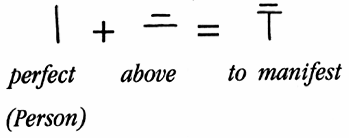In the beginning God created the heavens and the earth. NIV
In the beginning, when God created the universe,... TEV
 U
U T
T
Genesis 1:1
In the beginning God created the heavens and the earth. NIV
In the beginning, when God created the universe,... TEV
 U
U
 T
T
In Hebrew there are numerous names for God. Yahweh (Jehovah) is written
with only 4 consonants (YHWH,  ), so the vowels are unknown.
Yahweh is the personal name of God and has a meaning based on the verb, to be:
I AM, which is a statement of perpetual being, in the past, present, and future
- forever. When used in English versions of personal names it is shortened to
"...iah".
), so the vowels are unknown.
Yahweh is the personal name of God and has a meaning based on the verb, to be:
I AM, which is a statement of perpetual being, in the past, present, and future
- forever. When used in English versions of personal names it is shortened to
"...iah".
Elohim is a generic name, god or God. It is plural and yet is assigned singular verbs. This is typically understood to indicate a plurality of persons in the one God. In English God refers to the only true God, while god refers to beings and objects that are false gods. A short version is "El".
In an effort to avoid using the personal name of God in an inappropriate manner, the Jews used the name Adonai, meaning Lord, when the written text used Yahweh.
El Shaddai means God Almighty, referring to God's infinite power.
The original Chinese name for the one true God, the Creator, is Shang Di
 , meaning the God, or Emperor, above, the ultimate ruler.
(Shang
, meaning the God, or Emperor, above, the ultimate ruler.
(Shang  means above.) There are two oracle bone versions
of Shang Di,
means above.) There are two oracle bone versions
of Shang Di, 
 . The second
version has a 3-fold design, possibly suggesting mouths
. The second
version has a 3-fold design, possibly suggesting mouths  or persons, reflecting the Christian concept of 3 persons in the one God - the
Trinity.
or persons, reflecting the Christian concept of 3 persons in the one God - the
Trinity.
The first version may have many components. In Dr. Nelson's analysis she sees
3 other symbols for God:
 , then
, then
 , where
, where  (shi / to show, manifest)
(shi / to show, manifest)
There is a second form of the ancient character, looking more like the modern
version:  This gets compressed to
This gets compressed to  when it is the left part of a character.
when it is the left part of a character.
This is similar in meaning to the Greek source for "epiphany", which refers to
God showing himself.
It appears from the books that there may be two ancient forms of the right
side of another character for God. In bronzeware there is a character for
"instruction" which appears to be made up of two person characters
 joined end to end, with the second upside down, becoming
joined end to end, with the second upside down, becoming
 . These are combined with the God radical (manifest)
to make
. These are combined with the God radical (manifest)
to make  (Shen / God).
(Shen / God).
The second form uses symbols for hands:
The modern form of Shen (Traditional and
Simplified; the generic Chinese name for god or deity) is
The Chinese also have a way of avoiding the direct mention of God.
Tian means heaven (where God dwells), but also
sky, overhead, day, and season. The ancient form was built using a character
for a great or noble man and the character for above:
Whereas Shen is a weak word, meaning only god (a lesser being), there is another expression that seems most powerful. Tian Zhu means Lord of the Heavens:
The books reviewing ancient Chinese literature give Shang Di the same attributes
as Yahweh - a monotheistic God, the Creator of all things. And yet there are
similar indications of a plurality of 3 persons within the one God.

 (zhua / hand), with the thick
form coming from bronzeware and the thin forms from seal characters and oracle
bones. A vertical line was used to indicate a perfect person, with the further
emphasis of a black dot in the bronzeware version. Hands reaching down to the
person
(zhua / hand), with the thick
form coming from bronzeware and the thin forms from seal characters and oracle
bones. A vertical line was used to indicate a perfect person, with the further
emphasis of a black dot in the bronzeware version. Hands reaching down to the
person
 This is
combined with the God radical (manifest)
This is
combined with the God radical (manifest)
 to complete the second version
to complete the second version
 (Shen / God).
(Shen / God).
 ,
with the fingers still visible on the right side. Notice the meaning in the
symbols. God is the one who reached down to the first two people to instruct
them.
,
with the fingers still visible on the right side. Notice the meaning in the
symbols. God is the one who reached down to the first two people to instruct
them.
 .
A second form (
.
A second form ( ) and the bronzeware have a head which is
actually a flame, indicating the holiness or glory of God.
) and the bronzeware have a head which is
actually a flame, indicating the holiness or glory of God. 
 , therefore the ruler over everything.
, therefore the ruler over everything.
Back, Next
Beginning,
Oracle Bones,
God,
Water,
Earth,
Mankind,
Adam,
Eve,
Good Tree,
Bad Tree,
Penalty,
Clothes,
Lamb,
Gate,
Murder,
Flood,
Lifespans,
Scattering,
Border Sacrifice,
Genesis 1 to 11